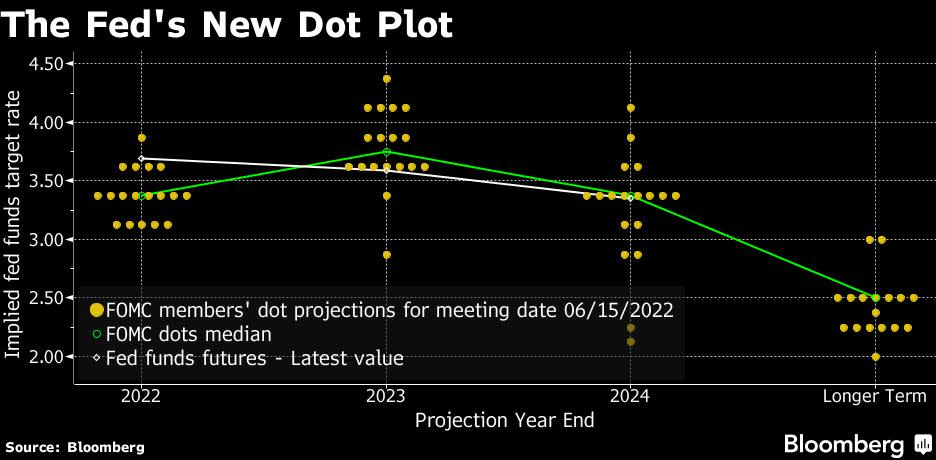Fed Heads Toward 75 Basis-Point Rate Hike With Officials Wary of Bigger Move

(Bloomberg) — Federal Reserve officials are on track to raise interest rates by 75 basis points for the second straight month when they meet later in July, after policy makers pushed back against a bigger move.
Most Read from Bloomberg
Investors reversed bets on a full percentage-point move after wary comments from officials including Atlanta Fed President Raphael Bostic and St. Louis’s James Bullard, plus a rare bit of good news on inflation.
Shortly after they both spoke Friday morning, data showed US consumers’ long-term inflation expectations declined in early July by more than forecast to 2.8%, versus 3.1% the month before.
Interest-rate futures contracts currently imply a roughly one-in-six chance that the Fed will hike rates by a full point this month, with a 75 basis-point hike regarded as certain.
“Based on what I have heard, absent the most important voice at the table, there seems to be a rally around 75 basis points” of tightening in July, said Mark Spindel, chief investment officer at MBB Capital Partners LLC, referring to Chair Jerome Powell.
The remarks at separate events Friday by Bostic and Bullard were the latest from officials to signal support for a 75 basis point move, which Powell told reporters last month was on the table for July.
The Fed in June raised the federal funds rate target by 75 basis points — the biggest hike since 1994 — to a range of 1.5% to 1.75%, after previously signaling it would hike by 50 basis points. Officials regard another 75 basis points as a powerful jolt to the economy, and are keeping an eye on how their policies are affecting growth. Housing markets appear to be cooling and there are scattered signs that consumption is leveling off.
“The real side looks to be softening. You don’t want to really overdo the rate hikes,” Fed Governor Christopher Waller said Thursday. “A 75 basis point hike is huge. Don’t say because you are not going 100 you are not doing your job.”
At the same time, officials are watching carefully how gauges of inflation expectations are behaving.
Longer-term market measures have come down in recent months, precisely because the Fed has delivered on aggressive policy, and officials understand that they have to continue to deliver if they are going to keep those expectations anchored around their 2% target.
“Inflation expectations are determined not only by movements in inflation but also by policy makers’ actions to follow through on their strongly stated commitment to return inflation to its longer-run goal — thereby justifying the public’s belief in the central bank’s commitment,” Cleveland Fed chief Loretta Mester said in a June 29 speech.
What it all means is that if inflation remains high — putting expectations at risk — the Fed is signaling it won’t hesitate to step harder on the policy brakes, even if that hurts the economy.
Traders boosted bets on a 100 basis-point increase earlier in the week after June’s consumer price index came in at a sizzling 9.1% annual gain. Those bets retreated Friday.
Bostic, speaking in Tampa, Florida, said he was wary of the bigger rate increase because “moving too dramatically I think would undermine a lot of the other things that are working well.”
He also said that he had a “Go Big” group in his bank, and “every time we get to a meeting, they are like, ‘We should just go, go, go.’ I am not in that group today.” Bostic doesn’t vote on policy this year.
Bullard was quoted earlier this week as saying he favored sticking with a 75 basis-point rate move. He declined to declare himself on Friday, but did say he backed raising rates to a range of 3.75% to 4% by the end of the year, rather than 3.5%. That implies about 2.25 percentage points of tightening from current levels. Bullard is a 2022 policy voter.
“I still don’t think they’ll do 100” basis points this month, said Derek Tang, an economist at LH Meyer, a Washington policy analysis firm. “It’s a close call, but it’s tactically unsound. How would they justify a downshift to 50 or 75” if inflation remains high.
Data between now and the meeting include more information on the health of the housing market, among other things, and some still see a risk of a larger move.
“There is still a lot of time between now and the July meeting. Everything is on the table,” said Lindsey Piegza, chief economist at Stifel Nicolaus & Co. “At the very least, we see a 75 basis-point hike. But I think there is a realistic possibility of a 100 basis point move.”
(Updates with more details.)
Most Read from Bloomberg Businessweek
©2022 Bloomberg L.P.




